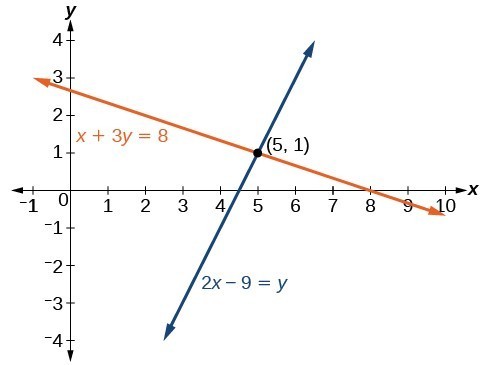Ordered Pairs as Solutions to Systems
Learning Outcomes
- Evaluate ordered pairs as solutions to systems
Determine whether an ordered pair is a solution for a system of linear equations
In this section, we will look at systems of linear equations in two variables which consist of two equations that each contain two different variables. For example, consider the following system of linear equations in two variables.How To: Given a system of linear equations and an ordered pair, determine whether the ordered pair is a solution
- Substitute the ordered pair into each equation in the system.
- Determine whether true statements result from the substitution in both equations; if so, the ordered pair is a solution.
 The lines in the graph above are defined as
The lines in the graph above are defined as
[latex]\begin{array}{r}2x-y=-4\\ x-y=-1\end{array}[/latex].
They cross at what appears to be [latex]\left(-3,-2\right)[/latex]. Using algebra, we can verify that this shared point is actually [latex]\left(-3,-2\right)[/latex] and not [latex]\left(-2.999,-1.999\right)[/latex]. By substituting the [latex]x[/latex]- and [latex]y[/latex]-values of the ordered pair into the equation of each line, you can test whether the point is on both lines. If the substitution results in a true statement, then you have found a solution to the system of equations! Since the solution of the system must be a solution to all the equations in the system, you will need to check the point in each equation. In the following example, we will substitute [latex]-3[/latex] for [latex]x[/latex] and [latex]-2[/latex] for [latex]y[/latex] in each equation to test whether it is actually the solution.Example
Is [latex]\left(-3,-2\right)[/latex] a solution of the system [latex-display]\begin{array}{r}2x-y=-4\\ x-y=-1\end{array}[/latex-display]Answer: Test [latex]2x-y=-4[/latex] first: [latex-display]\begin{array}{r}2(-3)-(-2) = -4\\-6+2=-4\\-4 = -4\\\text{TRUE}\end{array}[/latex-display] Now test [latex]x-y=-1[/latex]. [latex-display]\begin{array}{r}(-3)-(-2) = -1\\-3+2=-1\\-1 = -1\\\text{TRUE}\end{array}[/latex-display] [latex-display]\left(-3,-2\right)[/latex] is a solution of [latex]x-y=-1[/latex-display] Since[latex]\left(-3,-2\right)[/latex] is a solution of each of the equations in the system,[latex]\left(-3,-2\right)[/latex] is a solution of the system.
Answer
[latex]\left(-3,-2\right)[/latex] is a solution to the system.Example
Is [latex](3, 9)[/latex] a solution of the system [latex-display]\begin{array}{r}y=3x\\2x–y=6\end{array}[/latex-display]Answer: Since the solution of the system must be a solution to all the equations in the system, check the point in each equation. Substitute [latex]3[/latex] for [latex]x[/latex] and [latex]9[/latex] for [latex]y[/latex] in each equation. [latex-display]\begin{array}{l}y=3x\\9=3\left(3\right)\\\text{TRUE}\end{array}[/latex-display] [latex](3, 9)[/latex] is a solution of [latex]y=3x[/latex]. [latex-display]\begin{array}{r}2x–y=6\\2\left(3\right)–9=6\\6–9=6\\-3=6\\\text{FALSE}\end{array}[/latex-display] [latex](3, 9)[/latex] is not a solution of [latex]2x–y=6[/latex]. Since [latex](3, 9)[/latex] is not a solution of one of the equations in the system, it cannot be a solution of the system.
Answer
[latex](3, 9)[/latex] is not a solution to the system.Example
Determine whether the ordered pair [latex]\left(5,1\right)[/latex] is a solution to the given system of equations.Answer: Substitute the ordered pair [latex]\left(5,1\right)[/latex] into both equations.
[latex]\begin{array}{ll}\left(5\right)+3\left(1\right)=8\hfill & \hfill \\ \text{ }8=8\hfill & \text{True}\hfill \\2\left(5\right)-9=\left(1\right)\hfill & \hfill \\ \text{ }\text{1=1}\hfill & \text{True}\hfill \end{array}[/latex]
The ordered pair [latex]\left(5,1\right)[/latex] satisfies both equations, so it is the solution to the system. We can see the solution clearly by plotting the graph of each equation. Since the solution is an ordered pair that satisfies both equations, it is a point on both of the lines and thus the point of intersection of the two lines.
Think About It
Is [latex](−2,4)[/latex] a solution for the system [latex-display]\begin{array}{r}y=2x\\3x+2y=1\end{array}[/latex-display] Before you do any calculations, look at the point given and the first equation in the system. Can you predict the answer to the question without doing any algebra?Answer: Substitute [latex]-2[/latex] for [latex]x[/latex], and [latex]4[/latex] for [latex]y[/latex] into the first equation: [latex-display]\begin{array}{l}y=2x\\4=2\left(-2\right)\\4=-4\\\text{FALSE}\end{array}[/latex-display] You can stop testing because a point that is a solution to the system will be a solution to both equations in the system. [latex](−2,4)[/latex] is NOT a solution for the system [latex-display]\begin{array}{r}y=2x\\3x+2y=1\end{array}[/latex-display]
Try It
[ohm_question]48988[/ohm_question]Contribute!
Licenses & Attributions
CC licensed content, Original
- Determine if an Ordered Pair is a Solution to a System of Linear Equations. Authored by: James Sousa (Mathispower4u.com) for Lumen Learning. License: CC BY: Attribution.
- Revision and Adaptation. Provided by: Lumen Learning License: CC BY: Attribution.
- Determine if an Ordered Pair is a Solution to a System of Linear Inequalities. Authored by: James Sousa (Mathispower4u.com) for Lumen Learning. License: CC BY: Attribution.
CC licensed content, Shared previously
- Unit 14: Systems of Equations and Inequalities, from Developmental Math: An Open Program. Provided by: Monterey Institute of Technology and Education Located at: https://www.nroc.org/. License: CC BY: Attribution.
